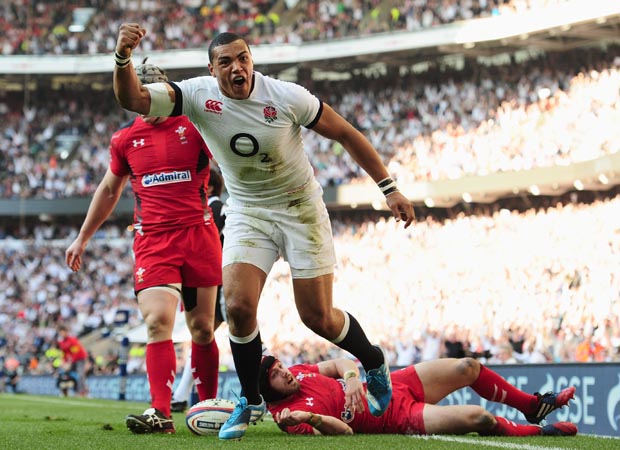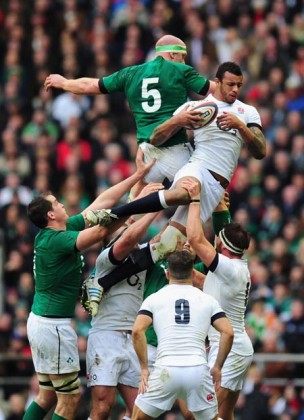
 If England can make the same progress over the next 18 months that they have made in the last year then they will be realistic world champion contenders by September 2015. However, the England squad will hopefully be wary of the tidal wave of superlatives heading their way from media cheerleaders following their 29-18 win over Wales at Twickenham last weekend.
If England can make the same progress over the next 18 months that they have made in the last year then they will be realistic world champion contenders by September 2015. However, the England squad will hopefully be wary of the tidal wave of superlatives heading their way from media cheerleaders following their 29-18 win over Wales at Twickenham last weekend.
The wave of hype might “carry them home” if there was a World Cup for hyperbole, but the reality is that Stuart Lancaster’s team, while promising, still have a way to go before they are on a par with New Zealand or South Africa.
Should they suffer a case of arrested development between now and the World Cup and not raise their game above the victory over Wales, or the split-decision win over Ireland a fortnight before that, they will not be good enough to beat either the All Blacks or the Springboks.
That reckoning with the world’s top two nations is for another day. For now, there are reasons to be cheerful, because England have made great gains over the last 12 months. These have been generated mostly by competition for places, some of it due to injuries, and some due to the selection fallout after last year’s Grand Slam failure.
PLUSES from the Six Nations
The biggest Six Nations bonus has been in attack. The arrival, at long last, of some midfield depth, with Billy Twelvetrees and three-try Luther Burrell combining effectively as a forceful new centre partnership, has seen to that. The unleashing of Mike Brown as a gifted counter-attacking force at full-back has also added a new dimension.
It is highly unlikely that if Brad Barritt and Manu Tuilagi had been fit that Twelvetrees and Burrell would have got a look-in, but the benefits have been priceless.
Burrell’s contribution to this campaign, although at 13 rather than his club position of 12, was the most eye-catching from a newcomer. The Northampton centre made the adjustment to Test level quickly, regularly putting himself in try-scoring positions and making few mistakes.
Twelvetrees grew in stature as a second play-maker as the tournament progressed, with his handling and kicking skills improving steadily until they culminated in the precision chip from which Burrell scored against Wales.
In the back three Brown demonstrated throughout why he was wasted on the wing last season, and his tackle to stop Jamie Roberts in his tracks contrasted starkly with a year ago at the Millennium Stadium when the two Welsh tries were scored down his wing by Alex Cuthbert.
The Harlequins full back’s bristling self-belief has underpinned his ability to find holes in the most miserly defences. Brown’s elusiveness and the core strength to shake off all but the best tackles are testament not only to his own work ethic but to the techniques developed by Margot Wells.
The gains made by Brown are an excellent advert for her as a speed and power coach, and Lancaster must be wondering whether others in his squad could benefit from a Wells tune up.
Jack Nowell and Jonny May, the two young wings introduced in the Six Nations by Lancaster, are a case in point. Both had a steady rather than spectacular start to their Test careers, but the darting Nowell could benefit from another metre in pace, and May from using his speed to run straight lines more often than those that go round the houses.
In terms of being sharp and direct Danny Care has been a shining example to his team-mates, and has sprinted ahead of Ben Youngs in the scrum-half rankings. Care exploited slackness around the fringes consistently this tournament – and by attracting defenders he takes pressure off Owen Farrell.
Against Wales the fly-half responded with a near perfect kicking game, whether it was for goal or from hand, and the accuracy of his distribution was another plus.
The continued development of the pack has given England greater authority, clearly evident in the improvement against a Welsh eight which had been totally dominant a year earlier in Cardiff.
The improvement up front is at its most notable in Joe Marler‘s emergence as genuine Test loosehead, and in the way Courtney Lawes has fulfilled his early promise to become a formidable second row force.
The increased depth in the pack was also evident in the way the injury to Billy Vunipola was absorbed, with Ben Morgan stepping in seamlessly at No.8 against Wales. The younger of the Vunipola brothers took the step up to international level impressively, and should be a force to be reckoned with for years to come.
The euphoria triggered by the win over the Welsh was predictable because it put one over the World Cup pool rivals, while also avenging last season’s humiliation.
Warren Gatland will now be concerned at the size of the obstacle that Wales have to surmount to get into the knock-out stages of the 2015 tournament, but the trick for England is to move on and become challengers capable of getting NZ coach Steve Hansen or his SA counterpart Heyneke Meyer glancing nervously in their direction.
To do that Lancaster and his coaches have to park the plaudits, because they will mean nothing if England are given a pasting on their next assignment, which is a daunting three-Test summer tour of New Zealand.
It was encouraging that England’s forwards coach, Graham Rowntree, did exactly that as England focused on closing their Six Nations account against Italy in Rome.
Until now not many England players had been in contention for an Anglo-Welsh XV let alone a World XV, but now all the talk is that England are brimful with world-class players.
Foremost among them, following Sir Clive Woodward’s flagging up of Joe Launchbury as the best young lock on the planet, is his second row partnership with Lawes.
Asked whether they had earned the world-class epithet Rowntree’s response was, “It’s too early – they are not world-class yet in my eyes. What I am seeing is a world-class attitude…they are willing to learn. They take criticism, and I am always on their cases.”
He added, “I go back to the word consistency. We had a better performance in the scrum at the weekend, but we still got shoved off a couple, particularly when Wales had fresh legs. We can’t have that.”
Rowntree is right to be cautious. There is serious work to be done on the England scrum because there are deficiencies in numerous areas.
MINUSES from the Six Nations
There was a stark contrast in the stability and competitiveness of the scrum against Wales when Marler was replaced by Mako Vunipola.
This emphasises that while the Saracens loosehead may be a hand-grenade in the loose it is not enough unless he can pull the pin and explode forward in the scrum as well. It was a vulnerability exposed in the elder Vunipola during the Lions tour, and it requires remedy because, should Alex Corbisiero return to full fitness, he would still be third in the pecking order.
Dylan Hartley has had rave reviews for the accuracy of his lineout throwing, and, in that area, they were fully deserved. However, his hooking skills were shown to be deficient against Wales and Ireland when he failed to relieve an under-pressure England scrum with clean, quick strikes to his No.8.
He and Tom Youngs need a prolonged tutorial, because if the scrummaging laws are retained – and there is growing momentum to keep them – then hookers who can actually hook will be at a premium.
The idea, too, that England’s lack of depth at tighthead has receded because David Wilson had the upper hand against Gethin Jenkins is also misleading. The bulk of the refereeing calls may have gone England’s way this time, but it is wishful thinking to describe them as the dominant scrum when either Wilson or Henry Thomas were on.
Thomas held up well in the couple of scrums he had to negotiate at the tail-end of the Wales and Ireland games, but until he plays at least 40 minutes he is an unknown quantity.
Praise has been heaped on the back five of the scrum as well balanced and mobile, and a combination of Lawes, Launchbury, and Dave Attwood covers most of the second row bases. However, the backrow is another matter.
There is a growing body of opinion that Chris Robshaw has put to bed all the arguments questioning whether he is a genuine openside flanker. The minority view, and the one I share, is that he is a very good captain and a back row forward blessed with a big engine and great hands – but that he does not have the instincts of an openside.
Robshaw is not a natural No.7 scavenger, as reflected in his low turnover rate in this tournament, and turnover ball properly used is as valuable as platinum. Although he is visible and influential – such as showing excellent timing and handling skills by springing Brown in the build-up to Care’s try against the Irish – he is not as adept at getting over the ball as Sam Warburton.
Nor are Robshaw’s backrow colleagues, Tom Wood or Morgan masters of the turn-over trade. Although they combine well, with Wood’s work-rate and intensity matching Robshaw’s, and Morgan providing the heavy-duty carrier, there is not yet enough aggression and impact in the tackle, or enough dynamism to the trio.
The more rarified the atmosphere the more essential it is to have multiple weapons in your armoury, and at the moment England are still missing a few. The responsibility for that is sometimes as much with the coaches as it is with the players — as was demonstrated by Lancaster’s selection decisions in the Paris defeat.
The England head coach robbed his side of momentum by subbing players who were the heartbeat of the team in Care, Lawes, Hartley and Marler. Lancaster’s leaning is to trust his bench to deliver where more experienced coaches would leave well alone.
It is a hard lesson, one that arguably cost another Grand Slam, but as long as they learn fast there are short-cuts to the top. After a couple of big stumbles England appear to be finding them.

1 Comment
You must be logged in to post a comment Login
Leave a Reply
Cancel reply
Leave a Reply
You must be logged in to post a comment.

Latest News
Super Rugby Americas: Round Ten Review

British and Irish Lions
British and Irish Lions: Biggest winners and losers from Andy Farrell’s selection



























Pingback: ติดตั้งโซลาเซลล์